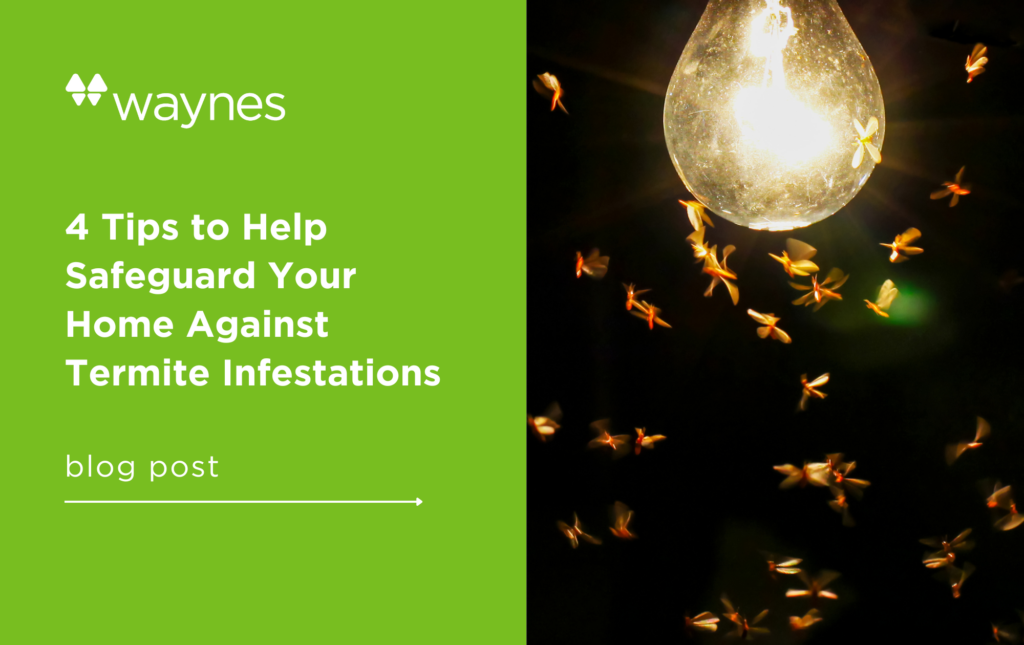Few things are worse than being told your home has termites. Well, nothing except finding out your insurance policy won’t cover the termite damage. Termites cause almost $5 BILLION of damage annually in the US, and you live in an area of intense termite infestation. Guess what? Spring marks the start of the season for these “silent destroyers.”
Common Types of Termites in the Southeast
Before determining what species of termite you are dealing with, let’s make sure what we are identifying is indeed a termite and not an ant. There are three identifying points:

It should be noted only swarmers, for both ants and termites, have wings.
Eastern Subterranean Termites | 1/8 inch long | Creamy white to dark brown/black
Eastern subterranean termites are of the most common species of subterranean termites spanning across the US. Living deep underground, the queen and her soldiers rely on the workers to bring back food. This food just so happens to be the wood holding your home up. Once full on the cellulose-rich wood, the workers take the food back to the colony to feed.
Drywood Termites | 1/4 to 3/8 inch in length | Creamy white to light brown in color
Just as the name suggests, these termites infest dry wood, such as furniture, lumber, firewood and other various untreated wooden objects. Because these termites feed off things commonly used in the house, it is relatively easy to accidentally bring them into your home. They can live in these extremely dry conditions by hyper-effectively extracting the remaining moisture from the wood. A tell-tell sign of a dry wood termite infestation is their pellet-like fecal matter. Fumigation or total replacement of the infested wood will be necessary to rid them from the home.
Formosan Termite | 1/2 inch | Creamy white to brown
One of the most destructive subterranean termite species prominently found in the southeast United States is the Formosan termite, sometimes called the “super termite.” These aggressive termites are difficult to control because they sometimes build carton nests above-ground and which limits their need to return to the ground for moisture. This is especially true when there is a moisture source in the structure such as a roof leak.
The Life Cycle of a Termite
Each species of termite has its own unique life cycle. For this blog, we are going to cover the basics of a termite’s life cycle. Most colonies are made up of the queen, soldiers, workers, and swarmers. Each plays a role in keeping the colony alive. Soldiers protect, workers repair and forage, and swarmers reproduce. As termites grow throughout the year, they molt, shedding their old exoskeleton.
Spring is the Start of Swarm Season
Termite swarmers are the reproducers of the colony, and therefore do not cause termite damage. Spring weather triggers the winged reproductive (swarmers) to emerge in large flying groups sometimes numbering in the thousands. It should be noted a termite swarm inside your home does not necessarily mean there is significant damage, however, it does mean that there is a termite infestation. Swarmers intend to emerge outside, but there are wrong turns made in every journey and sometimes they arrive in your home. You should alert your termite service provider if you see a swarm in or within 3-5 feet of your home. A sign a swarm occurred is seeing discarded wings.
Summer
Workers eat round the clock, newly coupled swarmers establish their own colonies, and the soldiers protect the queen.
Fall/Winter
The termites living outside of homes begin to go deep in the ground before freezing. Those living inside home continue feasting and living as usual.
Signs of Termites
- Mud tubes going from one food source to another found either in the interior or exterior of the home.
- Evidence of warped wood or bubbled paint
- Trails in the wood where they have consumed the wood
- Crumbling wood
- Shed wings near windows or doors
Termites are called “silent destroyers” for a reason; often these signs go unnoticed for long periods of time. It is vital you have a professional termite service inspect and treat your home.
How to Best Protect Your Home from Termites
DIY treatments will not cut it!! It takes a trained professional to spot the signs and properly treat to protect against a termite infestation.
Traditional liquid treatments begin to break down due to time, sunlight, and water exposure. With new research and development, Sentricon arrived on the market; it is the #1 brand in termite protection. Sentricon bait stations are not negatively impacted by the elements and become more attractive to termites over time.
Sentricon is proven to routinely eliminate the termite queen. The bait stations are removable and have no environmental restrictions around water sources and wells. The termite bait is 10 times more attractive to worker termites than wood. Workers ingest the bait and then take it back to the colony for consumption.
Your home is your castle. We’re your shield.
Protecting your home from termites is priority number one. Although no one can guarantee termites will not show up, when you’re a Waynes customer, you can rest easy knowing we are helping you protect your biggest asset 24/7 365 days a year. Need more? It’s backed by the single most comprehensive year-round termite coverage available. Call Waynes for your free consult. 1-866-WAYNES1









